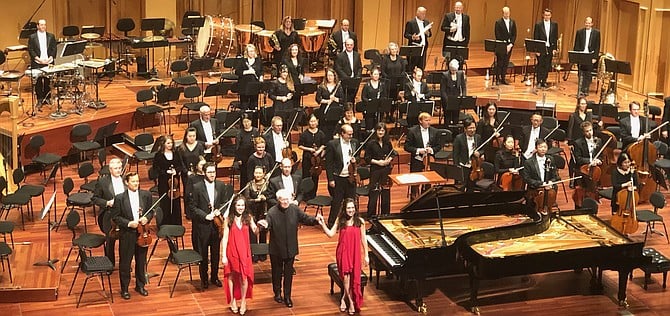 Facebook
Facebook
 X
X
 Instagram
Instagram
 TikTok
TikTok
 Youtube
Youtube

The San Diego Symphony’s 2017-18 Jacobs Masterworks Series came to a satisfying conclusion with concerts on May 25, 26, and 27. The concerts were conducted by maestro Edo de Waart who, you might recall, was the conductor for the opening concerts of the 2017-18 season.

These bookend concerts were two of the best of the season, as they should be. The concluding concert opened with a fresh, exciting rendering of Bernstein's Overture to Candide. This overture was hot, so hot one could almost smell the fat sizzling in the fires of the auto de fe from the first act—which Candide narrowly escapes.
By Pianoduo Mephisto with Chamber Orchestra of Belgium
Following the escapades of Candide and Pangloss was Poulenc’s gem of a concerto for two pianos. Twin sisters Christina and Michelle Naughton performed on duo pianos and proved that sometimes talent and looks do go together. I should amend that. Sometimes talent, looks, and about 100,000 hours of practicing the piano go together.
Poulenc’s concerto tends toward the pithy, which is to say concise and forcefully expressed. There is, however, a touching homage to Mozart’s pianistic style in the middle section. From the start of the piece I felt as though this was music which carried a certain sense of destiny. The orchestral forces are less than monumental but the concerto is a monument nonetheless. I had been looking forward to this concert for quite sometime and it exceeded my expectations at every turn.
The final piece of music of the season was Brahms’s Symphony No. 2. Brahms had a thing for making the violins wait. They don’t play at all in the first movement of his German Requiem and in three of the four movements in this second symphony they are preceded by the cellos and violas. But when Brahms invites them to play they play.
There is an image emblazoned in my mind from the middle of the first movement of the orchestra, led by the violins, in full bloom. The music Brahms composed here is sturdy, rigorous, confident, with massive joints encompassed by the frame of a titan and the San Diego Symphony was all of that.
The phrasing in the second movement had the right amount of emphasis at the right moments to bring out all the gloomy rays of sunshine which populate much of Brahms. The fourth movement brushed gloom aside as maestro de Waart whipped the orchestra into a full gallop.


The San Diego Symphony’s 2017-18 Jacobs Masterworks Series came to a satisfying conclusion with concerts on May 25, 26, and 27. The concerts were conducted by maestro Edo de Waart who, you might recall, was the conductor for the opening concerts of the 2017-18 season.

These bookend concerts were two of the best of the season, as they should be. The concluding concert opened with a fresh, exciting rendering of Bernstein's Overture to Candide. This overture was hot, so hot one could almost smell the fat sizzling in the fires of the auto de fe from the first act—which Candide narrowly escapes.
By Pianoduo Mephisto with Chamber Orchestra of Belgium
Following the escapades of Candide and Pangloss was Poulenc’s gem of a concerto for two pianos. Twin sisters Christina and Michelle Naughton performed on duo pianos and proved that sometimes talent and looks do go together. I should amend that. Sometimes talent, looks, and about 100,000 hours of practicing the piano go together.
Poulenc’s concerto tends toward the pithy, which is to say concise and forcefully expressed. There is, however, a touching homage to Mozart’s pianistic style in the middle section. From the start of the piece I felt as though this was music which carried a certain sense of destiny. The orchestral forces are less than monumental but the concerto is a monument nonetheless. I had been looking forward to this concert for quite sometime and it exceeded my expectations at every turn.
The final piece of music of the season was Brahms’s Symphony No. 2. Brahms had a thing for making the violins wait. They don’t play at all in the first movement of his German Requiem and in three of the four movements in this second symphony they are preceded by the cellos and violas. But when Brahms invites them to play they play.
There is an image emblazoned in my mind from the middle of the first movement of the orchestra, led by the violins, in full bloom. The music Brahms composed here is sturdy, rigorous, confident, with massive joints encompassed by the frame of a titan and the San Diego Symphony was all of that.
The phrasing in the second movement had the right amount of emphasis at the right moments to bring out all the gloomy rays of sunshine which populate much of Brahms. The fourth movement brushed gloom aside as maestro de Waart whipped the orchestra into a full gallop.
Comments